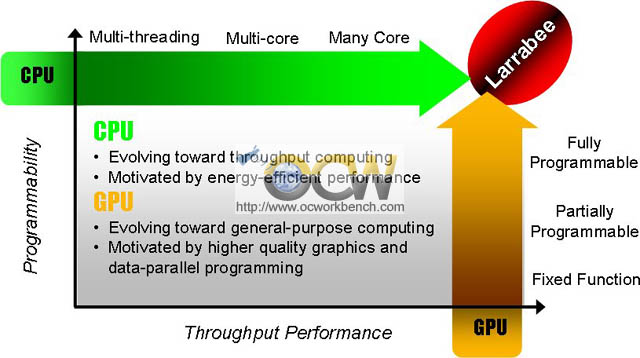|
Intel Larrabee a
multi-core x86 Intel architecture graphics engine
Bluetooth 4 Aug 2008
Introduction
FIRST DETAILS ON A FUTURE INTEL DESIGN
CODENAMED ‘LARRABEE’
Intel Corporation is presenting a paper at the SIGGRAPH 2008 industry conference
in Los Angeles on Aug. 12 that describes features and capabilities of its
first-ever forthcoming “many-core” blueprint or architecture codenamed “Larrabee.”
Details unveiled in the SIGGRAPH paper include a new approach to the software
rendering 3-D pipeline, a many-core (many processor engines in a product)
programming model and performance analysis for several applications.
The first product based on Larrabee will target the personal computer graphics
market and is expected in 2009 or 2010. Larrabee will be the industry’s first
many-core x86 Intel architecture, meaning it will be based on an array of many
processors. The individual processors are similar to the Intel processors
that power the Internet and the laptops, PCs and servers that access and network
to it.

Larrabee is expected to kick start an industry-wide effort to create and
optimize software for the dozens, hundreds and thousands of cores expected to
power future computers. Intel has a number of internal teams, projects and
software-related efforts underway to speed the transition, but the tera-scale
research program has been the single largest investment in Intel’s technology
research and has partnered with more than 400 universities, DARPA and companies
such as Microsoft and HP to move the industry in this direction.
Over time, the consistency of Intel architecture and thus developer freedom
afforded by the Larrabee architecture will bring about massive innovation in
many areas and market segments. For example, while current games keep getting
more and more realistic, they do so within a rigid and limited framework.
Working directly with some of the world’s top 3-D graphics experts, Larrabee
will give developers of games and APIs (Application Programming Interface) a
blank canvas onto which they can innovate like never before.
Initial product implementations of the Larrabee architecture will target
discrete graphics applications, support DirectX and OpenGL, and run existing
games and programs. Additionally, a broad potential range of highly parallel
applications including scientific and engineering software will benefit from the
Larrabee native C/C++ programming model.
Additional details of the Larrabee architecture discussed in this paper include:
* The Larrabee architecture has a pipeline derived from the dual-issue Intel
Pentium® processor, which uses a short execution pipeline with a fully coherent
cache structure. The Larrabee architecture provides significant modern
enhancements such as a wide vector processing unit (VPU), multi-threading,
64-bit extensions and sophisticated pre-fetching. This will enable a massive
increase in available computational power combined with the familiarity and ease
of programming of the Intel architecture.
* Larrabee also includes a select few fixed function logic blocks to support
graphics and other applications. These units are carefully chosen to balance
strong performance per watt, yet contribute to the flexibility and
programmability of the architecture.

* A coherent on-die 2nd level cache allows
efficient inter-processor communication and high-bandwidth local data to be
access by CPU cores, making the writing of software programs simpler.
* The Larrabee native programming model
supports a variety of highly parallel applications, including those that use
irregular data structures. This enables development of graphics APIs, rapid
innovation of new graphics algorithms, and true general purpose computation on
the graphics processor with established PC software development tools.
* Larrabee features task scheduling which is
performed entirely with software, rather than in fixed function logic. Therefore
rendering pipelines and other complex software systems can adjust their resource
scheduling based each workload’s unique computing demand.
* The Larrabee architecture supports four execution threads per core with
separate register sets per thread. This allows the use of a simple efficient
in-order pipeline, but retains many of the latency-hiding benefits of more
complex out-of-order pipelines when running highly parallel applications.
* The Larrabee architecture uses a 1024
bits-wide, bi-directional ring network (i.e., 512 bits in each direction) to
allow agents to communicate with each other in low latency manner resulting in
super fast communication between cores.

* The Larrabee architecture fully supports IEEE standards for single and double
precision floating-point arithmetic. Support for these standards is a
pre-requisite for many types of tasks including financial applications.
Discuss in Forum
Next >>>
|